There is an abundance of Chinese fruits that you can choose from, including standard options like lychee, persimmons, and mango, to more exotic options like goji berries, monk fruit, and even bayberries.
Thanks to the advantage of having vast geography, China’s climate is suitable for growing multiple types of fruits. You will be surprised at how diverse the regional fruit market in the country is since each area has its specialties.
To help you familiarize yourself with these delicacies before your next vacation, I’ve already compiled a list of popular Chinese fruits. This list will be helpful if you want to experience the fruity delights that China has to offer.
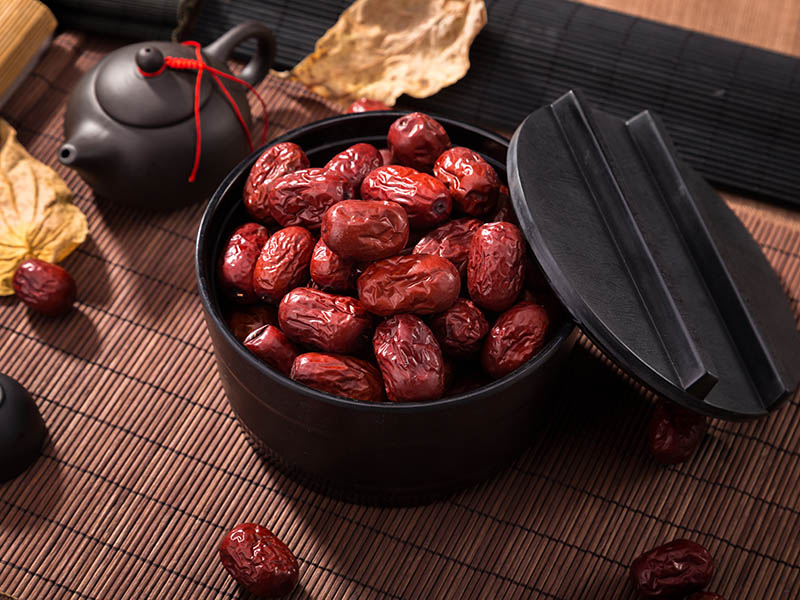
These Chinese Citrus Fruits Make Your Mouth Water
The best thing about citrus fruits is their ability to make your mouth pucker up, but at the same time, this sensation can also increase your appetite. These options will be great if you prefer sour fruits over sweeter ones.
1. Yuzu (Xiang Cheng)
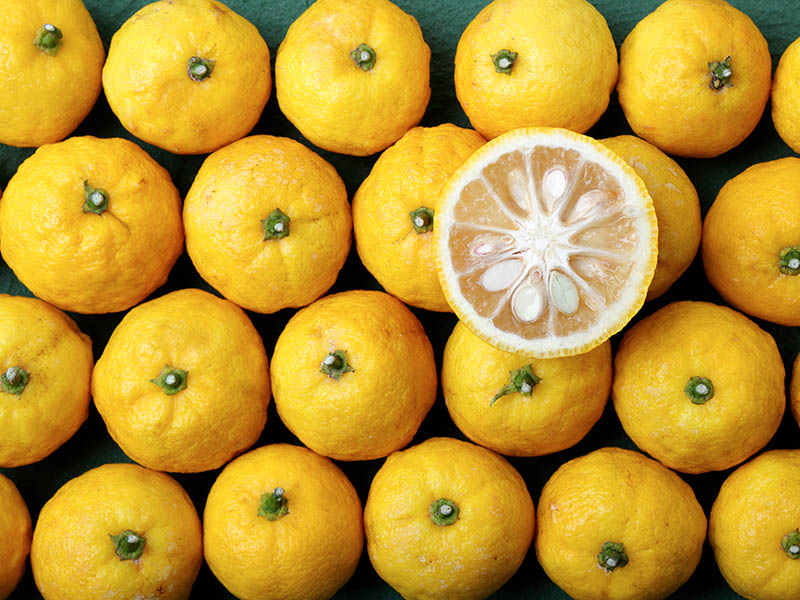
Yuzu or Xiang Cheng is a fruit that’s prevalent in a lot of East Asian markets. People believe the fruit might have originated from China, particularly in the Tibetan land, and soon spread to Korea and Japan during the Tang dynasty (7th – 10th century A.D).
Apart from Asia, the cultivation of Yuzu also takes place in many European countries like Spain, Italy, and France. A standard Yuzu tree has multiple large thorns, so the farmers tend to be really careful when harvesting the fruit.
The fruit has an oval appearance with rough and uneven skin. Unripe Yuzu fruit has a green and hard skin. When ripe, the color of this fruit is somewhere between a yellow and orange hue and the rind will be much easier to peel off.
The taste of Yuzu is quite sharp and citrusy, perfect as a seasoning for delicious Chinese dishes. You can use Yuzu juice as a drink.
Nutrients: Vitamin C, A, and B5, as well as a small amount of zinc, copper, and iron
Season: The fruit is available all year round, but you should buy it in the middle of winter.
How to eat: Just like a standard lemon, you cut the fruit open to squeeze out the juice or use the zest as a seasoning.
2. Kabosu Lime (Chou Cheng)
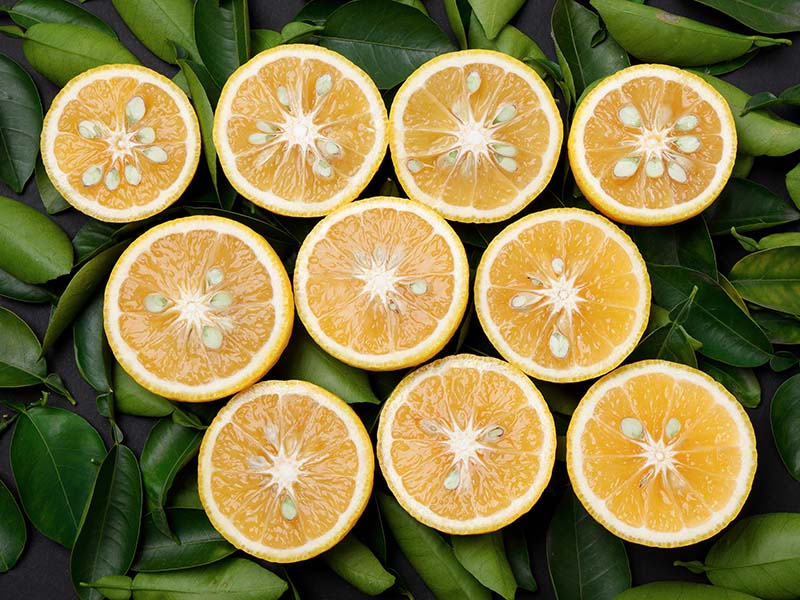
Like Yuzu, Kabosu is a species of citrus fruit that originated from China and spread to nearby East Asian countries, particularly in Japan during the Edo period (17th – 19th century A.D). The fruit is part of the larger Papeda citrus group, which also includes Sudachi and Kaffir lime.
Kabosu, or Chou Cheng as Chinese people call it, looks very similar to a lime, where the green hue and leathery skin might confuse some people. You can most find the fruit grown in a shrub that contains many thorns. People usually harvest Kabosu when it’s still green.
Although the fruit looks like a normal lime, the flesh has a yellowy-orange hue instead of the light green. Kabosu has a nice acidity that you can use in many delicacies, including grilled fish and hot pot. You can also find many alcoholic beverages infused with Kabosu essence in Asia.
Nutrients: Like other citrus fruits, Kabosu is rich in vitamins to strengthen your immune system. The fruit also has a high amount of potassium.
Season: Kabosu is most available during the fall season.
How to eat: You just need to cut the fruit open to squeeze the juice out.
3. Buddha’s Hand (Fo Shou)

When it comes to a comparison between Chinese and Vietnamese cuisine, one thing stands out: both cultures take full advantage of beautiful fruits in decoration. One noticeable example is the use of Buddha’s Hand or Fo Shou.
It is quite a unique fruit with a peculiar shape and an amazing aroma. This type of fruit might have originated from either China or northeastern India. Fo Shou has a very interesting appearance that resembles really long fingers.
Thanks to possessing such a distinct feature, many people refer to the fruit as a “Buddha’s Hand”, and it’s one of the most popular offerings in many Buddhist temples across China and Asia. The exterior of the fruit has a texture similar to a normal lemon.
The skin is quite wrinkly with a vibrant yellow. But when you chop the fruit in half, you will see that the core contains no pulp. However, Fo Shou has such an irresistible citrusy aroma that is perfect for infusion in food, drinks, and even perfume-making.
Nutrients: The fruit is high in Vitamin C, calcium, and dietary fiber.
Season: It’s available from late October to January, peaking in November.
How to eat: There are many ways to enjoy a Buddha’s Hand. You can chop up the fruit and eat it raw, or garnish a plate of salad with the fruit slices. Another way is to make candy out of the Buddha’s Hand.
This video will show you more about the taste of Buddha’s Hand.
4. Pomelo (You Zi)
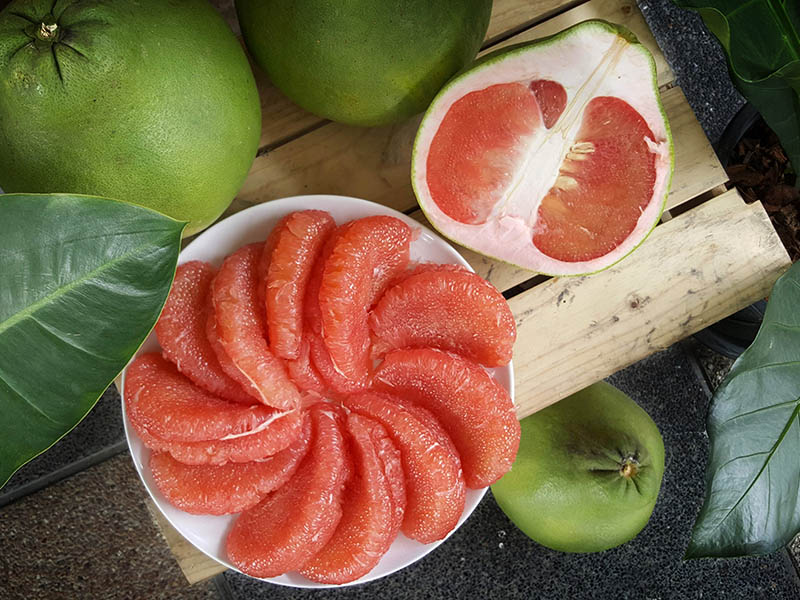
Pomelo is a fruit found in many East and Southeast Asian countries, and it’s one of the biggest species in the citrus fruit family. The arrival of Pomelo in China as You Zi took place pretty early, around 100 B.C.
The size of a standard Pomelo is impressive compared to other citrus fruits, measuring roughly 6-10 inches (15-25 centimeters) in diameter. Unlike other species in the citrus fruit family, you can easily peel and eat the core of Pomelo.
Despite being a citrus fruit, Pomelo does not have a high level of acidity. The smell of the skin is very pleasant. As for the pulp, you can feel a hint of sweetness within the tang. The color of the skin is a mix between greenish and yellowish.
Apart from the pure species of Pomelo, there are various hybrid versions of the fruit like Sweet Orange (Pomelo x Mandarin Orange) and Grapefruit (Pomelo x Sweet Orange).
Nutrients: The fruit contains vitamin C, copper, and potassium.
Season: Pomelo is available any time during the year, but you best buy it between December and February.
How to eat: Use a knife to peel the skin to reveal the core. The core, or pulps, goes well with a bit of salt.
This is a more thorough review of the Pomelo.
5. Kumquat (Jin Ju)
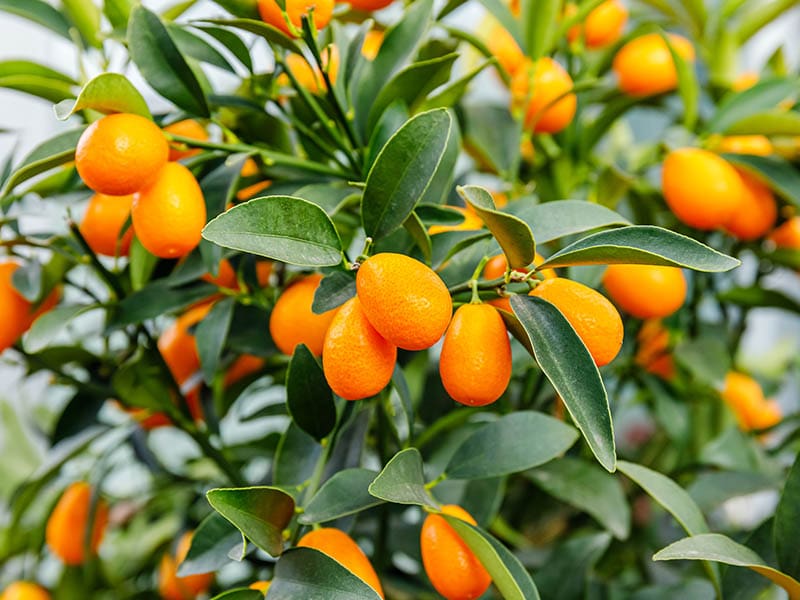
Kumquat, or Jin Ju, is a famous orange-colored fruit available in many Asian markets. This tiny citrus fruit originated in southern China, and the first recorded mention of Kumquat in the Imperial Chinese court was during the 12th century.
Before spreading to the European market in the 19th century, other nearby Asian nations like Japan, Korea, and the Philippines also knew how to cultivate the plant. There are multiple subspecies for Kumquat based on the shape and geographical location
For example, Round Kumquat looks quite similar to a round orange, with its orange hue and smooth skin. On the other hand, Oval Kumquat has less of a spherical shape. As for the geography-based subspecies, there are Hong Kong, Jiangsu, and Meiwa versions.
Kumquat has a sweet flavor but the more you eat into the flesh, the sour the fruit becomes. The tartness in the center is a unique feature of the fruit. In many Asian countries, you will see Kumquat made into marmalade and jelly.
Nutrients: Kumquat contains a lot of vitamin A, C, potassium, and calcium. Due to these elements, the fruit is good for your heart since it is able to burn through cholesterol. Kumquat can improve your immune system as well.
Season: The best season to get the fruit is in the middle of winter and early spring, particularly from November to March.
How to eat: To best enjoy Kumquat, eat the fruit whole without peeling. Remember to chew the fruit well as Kumquat will get sweeter the longer you chew it. Spit out the seeds if you find them bitter. You can cut the Kumquat open and juice the core, and you can also make marmalade out of the fruit.
6. Wampee (Huang Pi)
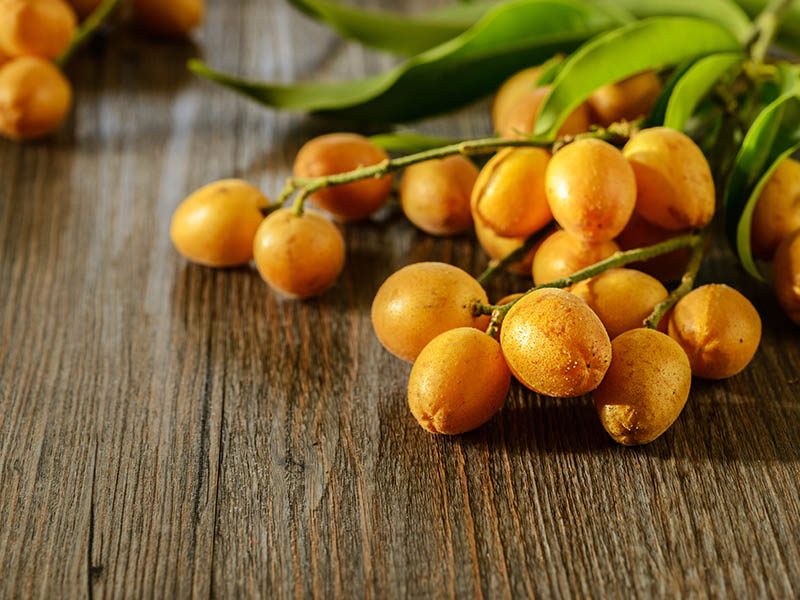
Wampee is the more westernized name for the Huang Pi fruit from China. This type of fruit is available in China, particularly in many Hakka communities and other Southeast Asian countries like the Philippines, Vietnam, and Indonesia.
Despite not looking like a normal lime or lemon, the fruit is in the same family as other citrus fruits. A Wampee tree usually stands at around 66 feet (20 meters), with white flowers blooming in March. This species is suitable in hotter climates of the tropic.
When you first look at Wampee, it seems like a more prominent and greener version of grapes. However, the fruit belongs to the citrus family. The diameter of a Wampee fruit is around 0.78 inches (2 centimeters). The taste has an apparent zing, similar to that of a kumquat.
Nutrients: Wampee is exceptionally rich in vitamin C B2 and B3. The fruit can help you balance out your cholesterol levels.
Season: The fruit is available in the middle of summer, from around June to July. Wampee species in cooler regions might grow fruit in fall, around August and September.
How to eat: The fruit is quite simple to prepare, you just have to peel the skin to reach the flesh. There are inedible seeds in the middle but you can remove them quite easily.
You Have To Try These Sweet Berries From China
The Chinese climate is also suitable for farming a variety of berry species. While you might think of the standard fruit like strawberries or raspberries, the selection goes further. Let me introduce you to a few exotic species that you can find in China.
7. Passion Fruit (Xi Fan Lian Guo)
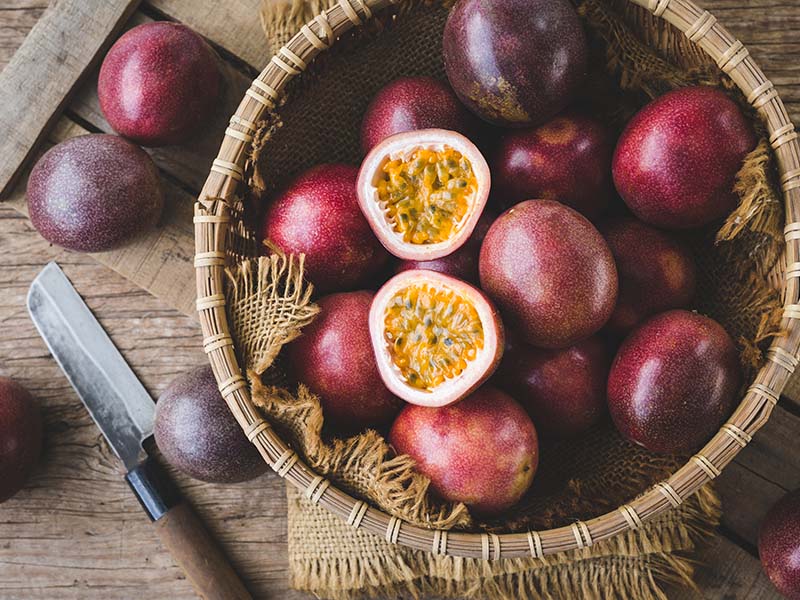
Nobody would think the species is in the same family as a strawberry when it comes to Passion Fruit. But surprisingly, these two fruits are related. Despite being a native fruit of South America, specifically Argentina, the fruit has gained quite a big following in China.
The fruit comes from the passion flower, with the name being a reference to Christianity. The appearance of Passion Fruit is quite appealing since its skin is very smooth and has a lovely shine to it. The version you will find the most in China is the purple Passion Fruit.
Looking further inside a Passion Fruit, you will see that the core consists of two things: the yellow flesh and the black seeds. The former has a sweet-and-sour aftertaste that creates the appeal of popular desserts with Passion Fruits. As for the seeds, they’re edible and quite crunchy.
Nutrients: This type of fruit is rich in vitamin A and C.
Season: Although the Passion Fruit is available all year round, the best season to get the fruit is still around June until next year’s February.
How to eat: Like every other fruit, you wash the Passion Fruit first before cutting it down in the middle. You can use a spoon to scoop out the flesh and seeds to eat them raw. On the other hand, you can strain the pulp to create Passion Fruit juice.
8. Wolfberries (Gou Qi)
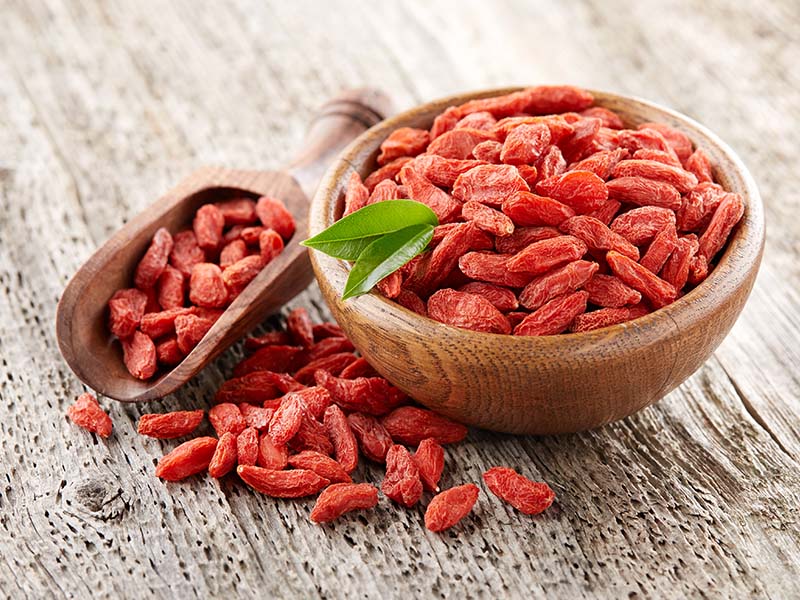
Wolfberry is the English translation for the name of this Chinese fruit called Gou Qi. This type of berry has been a big part of Asia for centuries, including in countries like China, Japan, and Korea. In Particular, China has been the largest producer of wolfberries for many years.
In Chinese regions like Ningxia and Xinjiang, the number of wolfberries produced can reach staggering tens of thousands of tons. One of the most common uses for Goji berries is in traditional eastern medicines.
The color has a very vibrant red hue with ripped berries to it. In many places selling eastern medicines, people tend to get the dried version, which is thinner and wrinklier than the standard berries. The flavor leans more on sweetness instead of sourness.
Nutrients: Goji berries are rich in vitamin C and C as a fruit. They also contain iron and fiber to help your metabolism.
Season: The fruit is available between summer and winter.
How to eat: Goji berries are easy to eat since you don’t have to peel anything. You can also dry out the berries to eat as an alternative to raisins.
The harvest of Goji berries in China is really interesting.
9. Persimmons (Shi Zi)
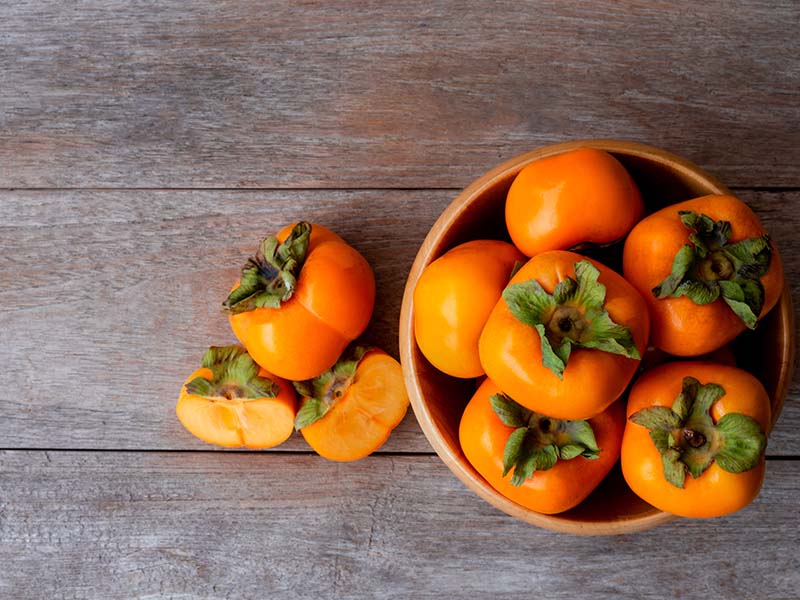
In this entry, I want to focus only on the Oriental Persimmons as there are other Persimmon species coming from other parts of the world. This version originated from the region around China, northeast India, and Indochina (a region encompassing Laos, Cambodia, and Vietnam).
This type of persimmon is similar to tomatoes in both appearance and family type. However, while the latter has a lot of sourness and umami flavor, the former is very sweet and suitable for many delightful Chinese recipes. The most common version of this fruit is the Oriental Persimmons.
When you take in the appearance, the color of Persimmons can range from yellow to orange. The core of a standard Persimmon is quite fleshy, and the seeds are edible. This fact means you can just bite into the flesh easily.
There are two types of Oriental Persimmons, astringent and non-astringent. This factor will determine whether or not the Persimmons will be sour and dry when they’re unripe.
Nutrients: The fruit is full of vitamins, copper, and manganese.
Season: Persimmons are most abundant from October to January.
How to eat: You can just bite through the fruit since the skin is thin and soft or cut the fruit in half to enjoy the sugary flavor.
10. Star Fruit (Yang Tao)
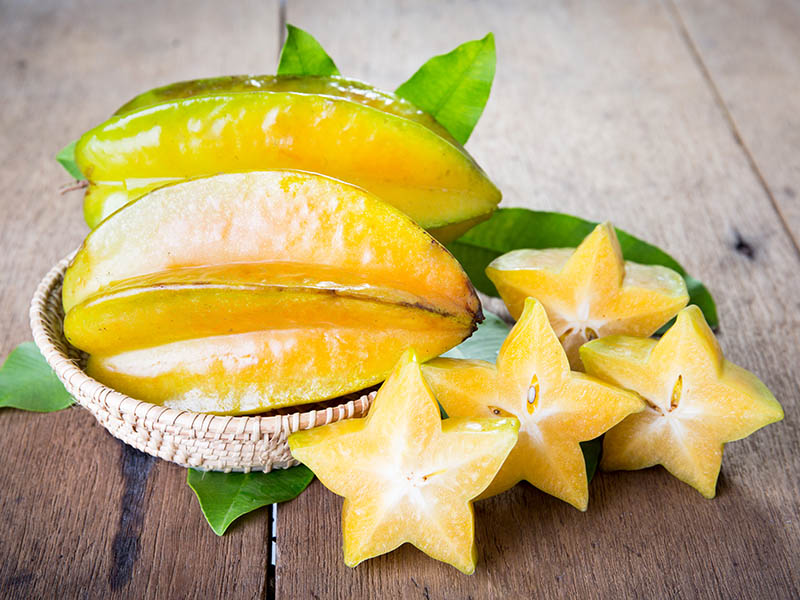
Star Fruit is one of the unique fruits you will come across in your lifetime. The most eye-catching aspect of the fruit is in appearance, where the ridges can form an exciting star shape. The standard size of a Star Fruit is around 2-6 inches (5-15 centimeters)
The fruit is suitable for tropical climates, that’s why it has become a staple in many various regions, including Southeast Asia (the true place of origin for Star Fruit), Brazil, and China. There are various versions of Star Fruit, including yellow to green ones.
The inside of the fruit has a waxy layer that covers its entire length. The taste of this fruit depends on the type, as you can find either sour or sweet Star Fruits on the market. The texture is fleshy and juicy, but the outer skin can be tough to chew.
Nutrients: The fruit contains fiber, vitamins, and copper.
Season: You can find the most Star Fruits around October to December.
How to eat: You can cut the fruit straight along the ridge or perpendicular to the spine. There is no need to peel the skin off.
11. Kiwi (Mi Hou Tao)
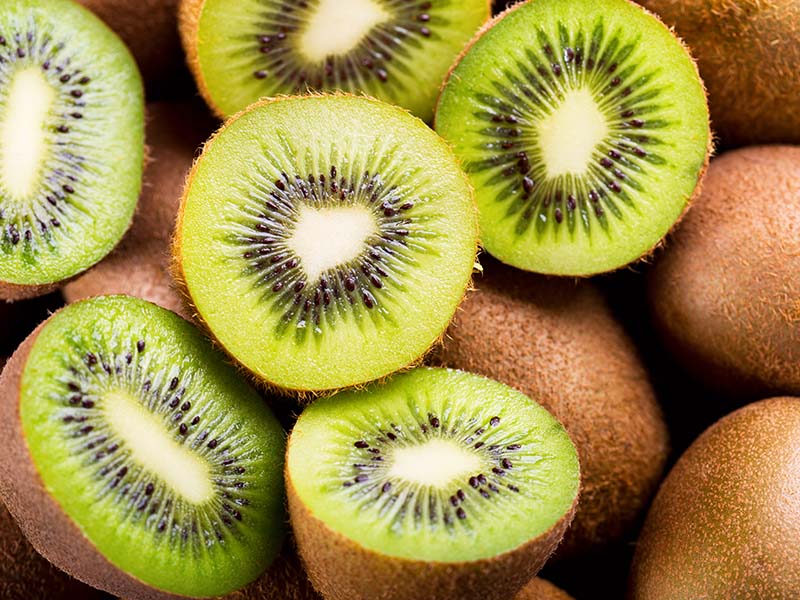
Although people mainly associate Kiwis with the country of New Zealand, did you know that the proper place of origin for the fruit is China? That’s right, Chinese people knew how to identify Kiwis in the Song dynasty (10th – 13th century A.D). Therefore, it’s also called Chinese gooseberry.
But at that time, China only used the fruit for medicinal purposes. It was thanks to New Zealand that the fruit became a popular dessert. The fruit even got the name Kiwi from a species of Kiwi bird in New Zealand.
The fruit has a lovely fragrance, and the core is green with little black seeds. When you eat the fruit, you can feel a pleasant sweetness with notes of ripe gooseberries and citrus spreading to your taste buds. The size of a Kiwi fruit is around 2-3 inches in length (5-8 centimeters).
Nutrients: Kiwis contain many nutrients, including vitamin K, copper, and potassium.
Season: The most common period you will see Kiwis in China is between September and October.
How to eat: First, peel the skin off the fruit and then slice the Kiwi fruit into thin portions. The seeds are also edible.
12. Banana (Xiang Jiao)

Banana is one of the oldest fruits that humans know how to cultivate. The origin of the fruit started in Southeast Asia and Southern China, as well as in Australia. Currently, China is one of the world’s biggest producers of Bananas.
Since Bananas are one of the most popular fruits worldwide, everyone has seen and tasted them already. The skin is usually green when the fruit is unripe and turns yellow when fully mature, signaling that it is ready for brilliant banana dessert ideas.
Most green bananas will have a sourness in their flavor. However, the taste usually disappears when the bananas turn yellow, replaced by a lovely sweetness. Aside from being a healthy dessert, Banana is also a popular ingredient in cooking savory food.
Nutrients: Bananas are fantastic if you want to supplement vitamins and potassium.
Season: Banana is an excellent fruit to enjoy daily since it’s available all year round.
How to eat: Peel the skin off before eating the starchy and sweet flesh.
13. Dragon Fruit (Huo Long Guo)

Although most people often associate Dragon Fruit with Asia, the true origin of the fruit is in Central America, particularly Mexico. However, the fruit is suitable for many tropical and subtropical countries around the world, like India, Australia, and, of course, China
The regions with the highest amount of Dragon Fruits growing in China are Guangxi and Guangdong, where they provide up to 60% of Dragon Fruits to the entire country.
Based on the fruit’s appearance, you can understand why people call it Dragon Fruit. The exterior is quite scaly. The colors, including purple and green, genuinely captivate your attention. The flesh is delicious and sweet. The crunchiness of the tiny black seeds offers a nice texture.
Since the fruit originates from a cactus, this means that you should never overwater the plant because it would cause an undesirable effect on the crop.
Nutrients: Dragon Fruit is rich in vitamin C, iron, and magnesium.
Season: The fruit is available in the summer, from June to September.
How to eat: The best way to enjoy a Dragon Fruit is just peeling the skin and eating the flesh. Don’t worry about the seeds since they’re small and harmless.
China-Based Drupe Fruits Are The Best
To put it simply, the drupe family is the type of fruit where you can see a fleshy core surrounding a single seed. Drupe fruit farming is one of Asia’s most common agricultural practices, especially in China, with its perfect soil condition.
14. Longan (Long Yan)
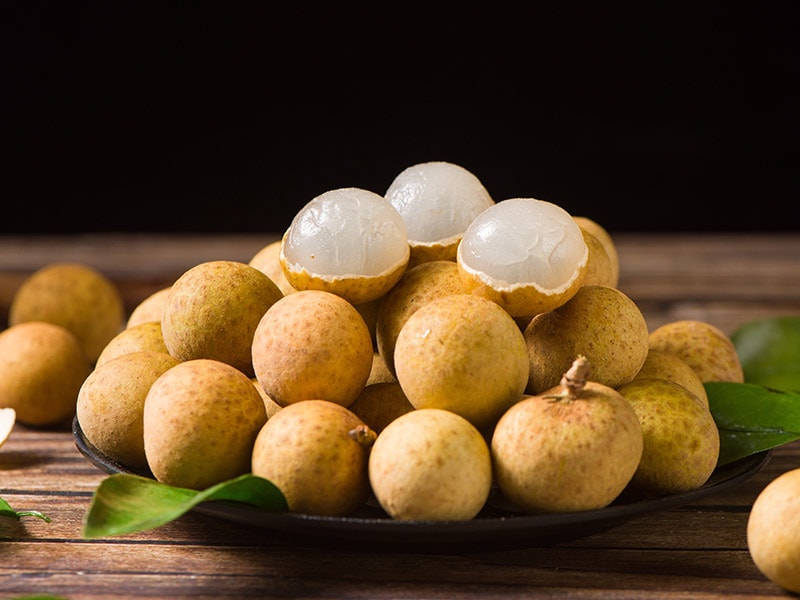
One of the most popular Chinese fruits is Longan or Long Yan in Chinese. The name translates to “Dragon’s Eye”, which is a reference to how the flesh and the seed look like an eyeball. The actual birthplace of Longan lies between the southern region of China and Myanmar
The first mention of the fruit in Chinese history was during the Han dynasty (3rd century B.C – 3rd century A.D). Longan has a lot of uses in Chinese cuisine, from being a standalone dessert to being an ingredient in many local delicacies.
Longan is also very nutritious since the fruit is part of traditional Chinese medicine. The fruit contains minerals like calcium, iron, and magnesium. You can absorb such nutrients by eating raw longans or turning them into delicious treats, such as Air Mata Kucing, a great Malaysian drink.
Longan comes in three separate parts. The first part is the skin, which is easy to peel but inedible. The next part comes with the sweet, fleshy pulp that tastes somewhat similar to a lychee. The final part is the black seed. You can quickly grow a Longan tree with just one seed.
Nutrients: Longan contains a lot of vitamin C and minerals like phosphorus and magnesium.
Season: In China, the harvest season for Longan is around July to September.
How to eat: Peel off the skin to eat the spongy and sugary flesh. Remember to get rid of the seeds.
15. Lychee (Li Zhi)
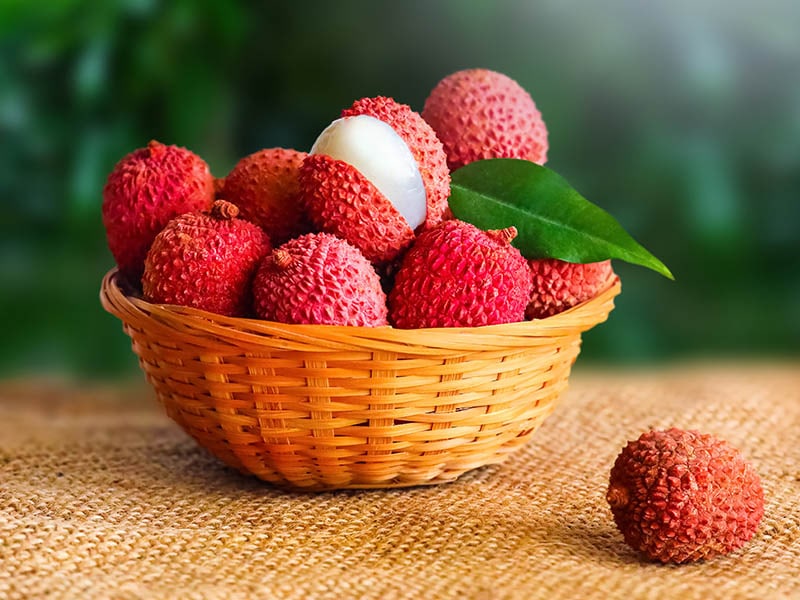
Another popular Chinese fruit in the drupe family is the Lychee or Li Zhi, which came to China around the 11th century. You can find a lot of plantations for Lychee in Chinese provinces like Fujian, Guangdong, and Yunnan. This type of plant favors a more tropical climate.
A normal Lychee tree stands at around 49 feet tall (15 meters). The normal range where a Lychee bears fruit is between 80 and 112 days. The fruit is mostly oval or round in shape. Similar to Longan, the skin is quite rough and inedible.
The inside of a Longan fruit is very fleshy, sugary, and juicy. Once you get through the part, you can come across the black seed. Lychee has multiple uses in Chinese cuisine, but most of the time, people like to have it fresh.
Nutrients: Lychee is full of vitamin C, copper, and potassium.
Season: Lychee season is between mid-May and mid-July.
How to eat: Just peel off the skin to eat the flesh until there is only a seed left.
16. Rambutan (Hong Mao Dan)

Rambutan or Hong Mao Dan might look a bit hairy, but I think you will fall in love with this fruit soon due to its fragrance and taste. Despite being quite popular in China, the origin of the fruit came from Southeast Asia, specifically in the Indo-Malaysian region.
Similar to other drupe fruits, Rambutan usually grows from an evergreen tree, which is a type of plant that stays green after its season. Normally, the fruit grows to around 1-2 inches (3-6 cm) in length.
The first thing that will catch your eyes is the little strands of “hair.” However, if you peel the skin, the core will reveal itself. The flesh is sweet and creamy. Unlike other longan and lychee, the seed from Rambutan is rather white.
Nutrients: The nutrients you can find in Rambutan are vitamin C, copper, and magnesium.
Season: The fruit is available during the fall and winter.
How to eat: Peel off the skin to eat the flesh. Remember to throw away the seed.
17. Bayberry (Yang Mei)
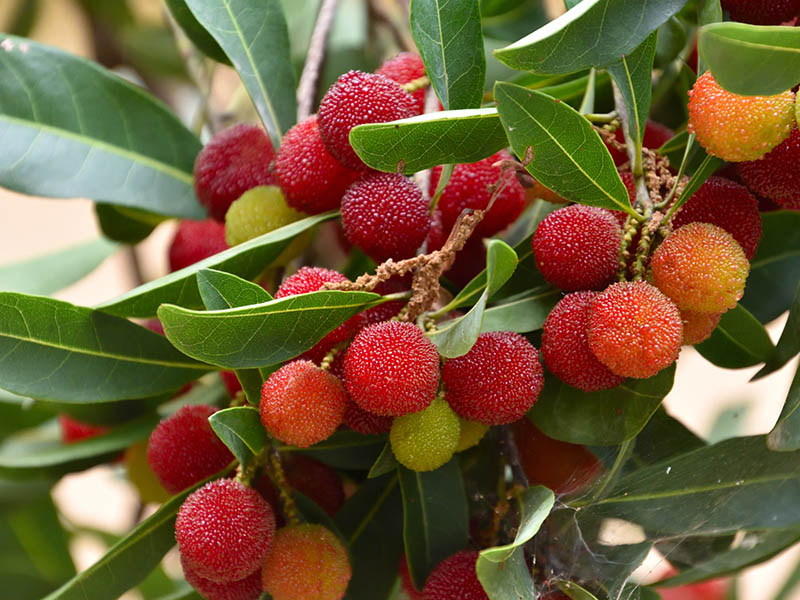
Bayberries are a genus that you can find distributed all over tropical regions of the world. But in this specific entry, I want to focus more on the East Asian version. This version usually develops flowers around March-April, and the fruit’s growth period is in June.
Although the fruit has the word “berry” in its name, Yang Mei is more similar to lychee and rambutan than a standard berry. The fruit is available in the eastern side of Asia, specifically in regions of China like Fujian and Sichuan.
Bayberries look similar in color to lychee because of their red rinds, although the hue on Bayberries might be a bit darker. You can use the fruit to make plenty of Chinese beverages. The taste is sugary, but not overwhelming.
Nutrients: The fruit is rich in antioxidants like vitamins A, C, and E.
Season: The season for Bayberry is around June in China.
How to eat: The way to eat Yang Mei is simple. First, you clean the fruit as it might be full of dirt. After that, you just pop the fruits right into your mouth. However, there are little pits inside so you have to be careful.
18. Green Plum (Ou Me)
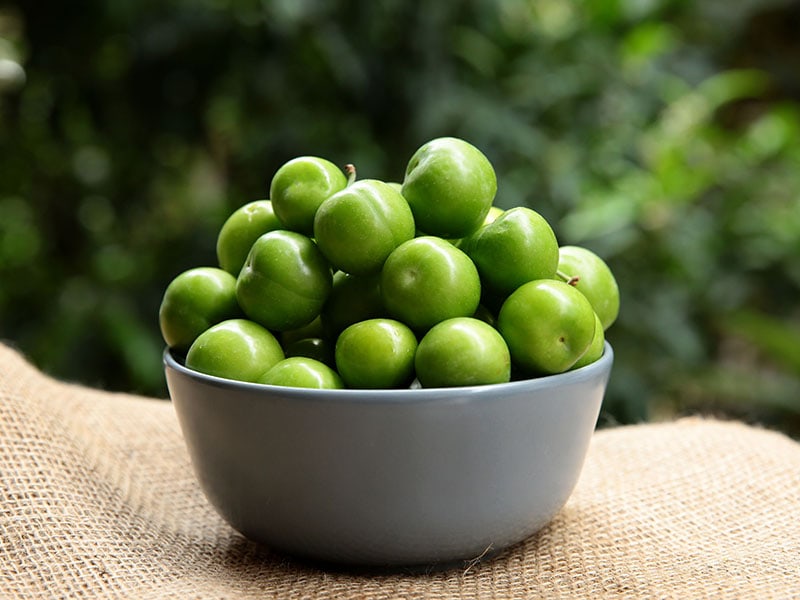
Plum is a species of fruit found in many parts of the world. But for today, I want to focus on Green Plum or Oume, a version that’s native to China. The actual place of origin for Oume is around the basin of the Yangtze River.
In China alone, there are hundreds of different Ou Me species, including groups like Upright Mei, Pendulous Mei, and Tortuous Dragon. The fruit of a standard Ou Me is green, but you will most see a type of dried Ou Me sold with a brownish hue.
Apart from China, the fruit is quite popular in Japan and Korea thanks to the spread of Chinese culinary influence. Oume is an essential ingredient in Chinese cuisine to make food like jam (Meijiang) or drinks (Suanmeitang).
Nutrients: Oume is a good source of vitamins C, K, and A.
Season: The best season to harvest Oume is from June to July.
How to eat: Due to the sourness of the Chinese plum, the fruit is more suitable as a condiment for Chinese delicacies. In some cases, the plum can be a good ingredient for a refreshing drink.
19. Jujube (Hong Zhao)
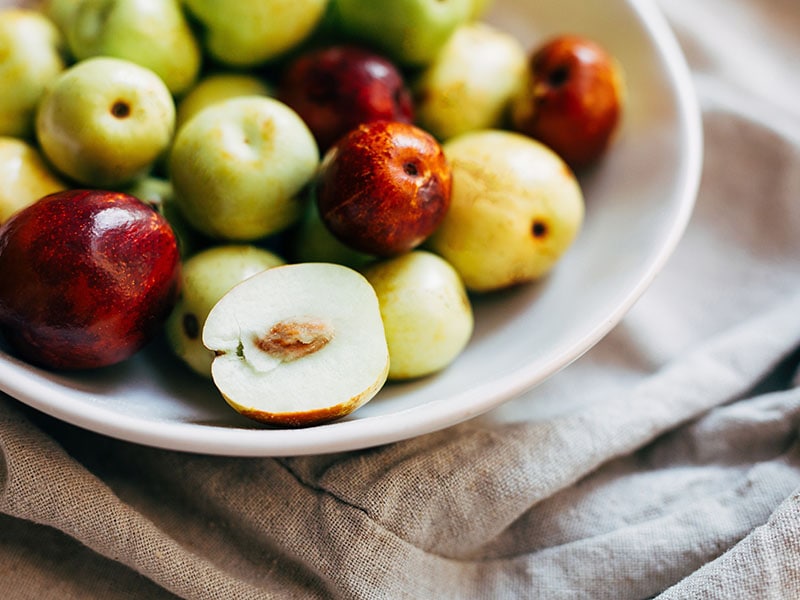
In China, Jujube is also known as Red Apple or Hong Zhao. The reason is its resemblance to an apple but in a smaller size. The place of origin for Jujube was around South Asia. However, the plant eventually made its way to China, particularly Beijing.
The leaves of a Jujube plant are quite shiny, and the size of the tree stands around 16-39 feet (5-12 meters). The plant has a high tolerance to different temperatures and climates, including mountainous terrains and deserts.
More often than not, after a harvest, farmers tend to dry the fruit before selling it. One of the best ways is to add Jujube to Chinese sweet soups. Another use for Jujube is as part of traditional medicine because the fruit has a lot of fiber and antioxidants (vitamin C)
Apart from medicinal use, Jujube is a popular ingredient for various sweet tea products as a way to improve their flavor. It is also great in alcoholic beverages.
Nutrients: Jujube is rich in fiber, vitamin C, and potassium.
Season: The best season to get Jujube is from January to March.
How to eat: Cut the fruit in half. Both the flesh and skin are edible, but the seed is very hard.
Jujube is an iconic part of Chinese cuisine.
20. Mango (Mang Guo)
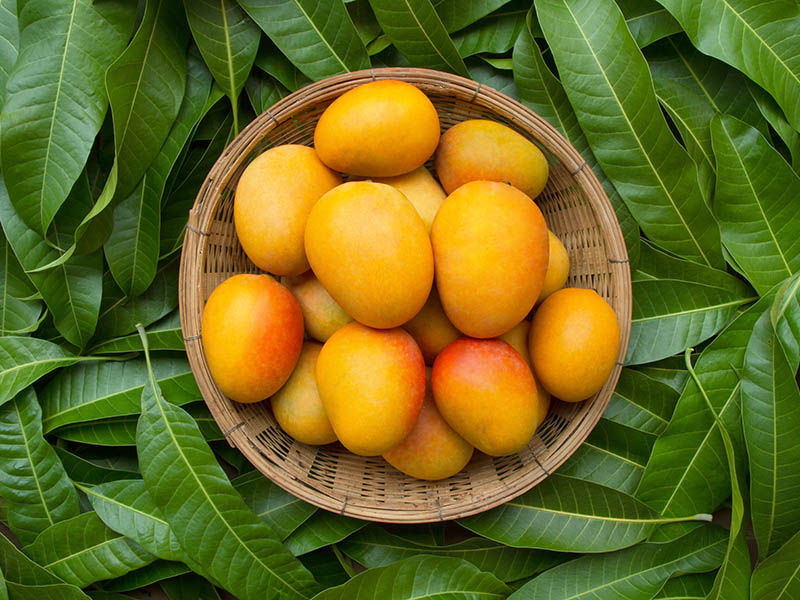
Mango is a type of fruit indigenous to South and Southeast Asia. Despite this, China has risen to become one of the biggest producers of Mango globally. You will see many Mango farms when you visit Yunnan, Hainan, and Sichuan.
The average mango tree will grow to around 98-131 feet tall (30-40 meters). The preferred climate for Mangoes is the tropics. In China, you can see a lot of carts selling Mangoes from April to June.
The most popular variant of Mango is the yellow version. The exterior has smooth skin, which you can peel off with a knife to reveal the sweet flesh. By contrast, the flesh of an unripe one is always hard and acidic, but it is still suitable for some popular mango recipes.
Mangoes have many uses, from being a refreshing dessert after a meal to a flavoring ingredient in drinks and ice cream.
Nutrients: As a type of fruit, Mango is rich in vitamins C, A, K, and E.
Season: The harvest season of Mango is around April to September in China.
How to eat: As I said above, you can peel the skin to eat the fleshy part of the fruit. The seed is hard and inedible, though.
Experiencing Exotic Taste With Multiple Fruits In China
The great thing about the Chinese climate is that you can grow many different plants, from species that prefer mild temperatures to tropical species. In this subsection, I want to show you more about the tropical fruit selection in China.
21. Pineapple (Bo Luo)
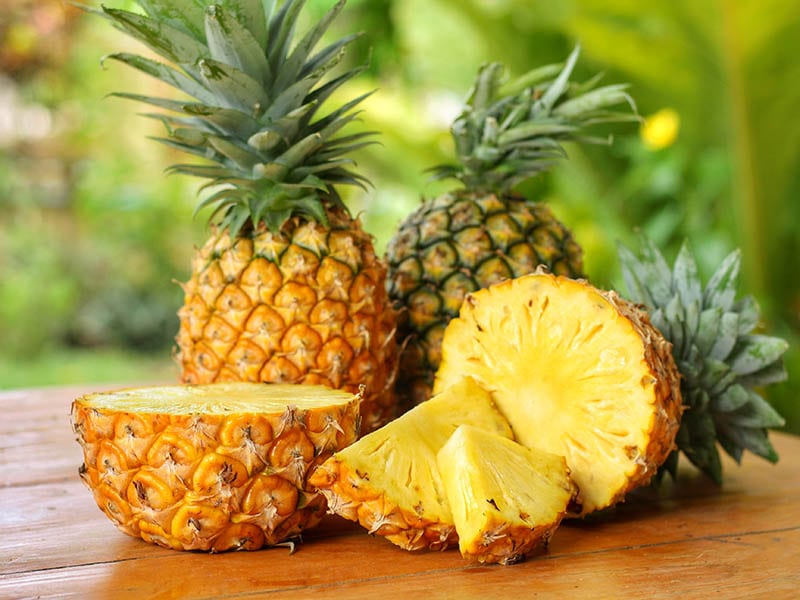
When it comes to tropical fruits, the first thing that will pop into your head is Pineapple. Even though pineapple is not from China but instead from South America, the fruit is well-loved among Chinese people.
The pineapple has a very distinct shape that you can never mistake. The fruit has a rough exterior with many pointy parts that can irritate your skin. However, the core is quite delicious with its sour and slightly sweet flavor. The texture of the flesh is quite crunchy.
The fruit is mostly a part of Guangxi, Guangdong, Hainan, and Yunnan’s agricultural exports in China. The importance of pineapple is high in these regions.
Nutrients: The fruit contains so many antioxidants to keep your skin youthful.
Season: The perfect period to get pineapple is from March to July but you can buy them year-round.
How to eat: The skin is inedible, so you have to peel it to get to the flesh. Do not eat the middle since that part is the core and quite hard.
22. Jackfruit (Bo Luo Mi)

Jackfruit, or Bo Luo Mi as its Chinese name, is a tropical plant species that originated in many South Asian regions, particularly in Bangladesh and Sri Lanka. The fruit is also available in the forests of the Philippines and Malaysia.
With increased trade, the fruit also came into China during the reign of the Tang dynasty (7th – 10th century A.D). Once again, like many species above, Jackfruit comes from an evergreen type of tree.
The average diameter of a Jackfruit is around 6 to 20 inches (15 – 50 centimeters). On the exterior, there is a layer of rough and pointy skin. Jackfruit has a fruity and intense aroma. If you’re not used to it, the smell can be unpleasant.
When you get into the core, the flesh consists of yellow bits that can be very sweet. These bits have a velvety smooth texture, but they can be quite tough to chew.
Nutrients: Jackfruit contains manganese, proteins, and fiber.
Season: You can find ripe Jackfruit from March to June or April to September.
How to eat: You have to cut open the protective outer layer to get into the flesh of a Jackfruit. The core contains many fleshy yellow bits that are edible. Jackfruit flesh is very sweet, chewy, and sometimes oily. Unripe Jackfruit is also edible as an ingredient for an Asian-styled salad.
Other Chinese Fruits That Will Give You A Detox
Apart from the categories above, here is a list of other entries that do not belong in any fruit families. While they might be outcasts, it doesn’t mean these fruits will not bring you the same refreshing feeling.
23. Monk Fruit (Luo Han Guo)

Monk Fruit or Luo Han Guo is a native plant to the southern side of China and parts of northern Thailand. In China, the first mention of the fruit came from a monk in the 13th century in the Guangxi region, hence why the fruit got its name “Monk Fruit”.
Fresh Luo Han Guo has a dark brown hue; the skin is quite leathery and shiny. On the inside of the fruit, there is a pulp that you can eat. The most common way to prepare Luo Han Guo is to dry the fruit and make an herbal drink out of the dried husk.
This type of fruit has a long association with traditional Chinese medicine due to its health benefits. Aside from being a popular herbal drink, many people take advantage of Luo Han Guo to create an artificial sweetener.
Nutrients: The fruit is good for weight loss and preventing diabetes.
Season: The best harvest season for the fruit is in September.
How to eat: Most people tend to dry Monk Fruit before using it. After drying, producers take out the seeds and use the pulp to make drinks.
This video will explain what the Monk Fruit is.
24. Mulberries (Sang Shen Zi)
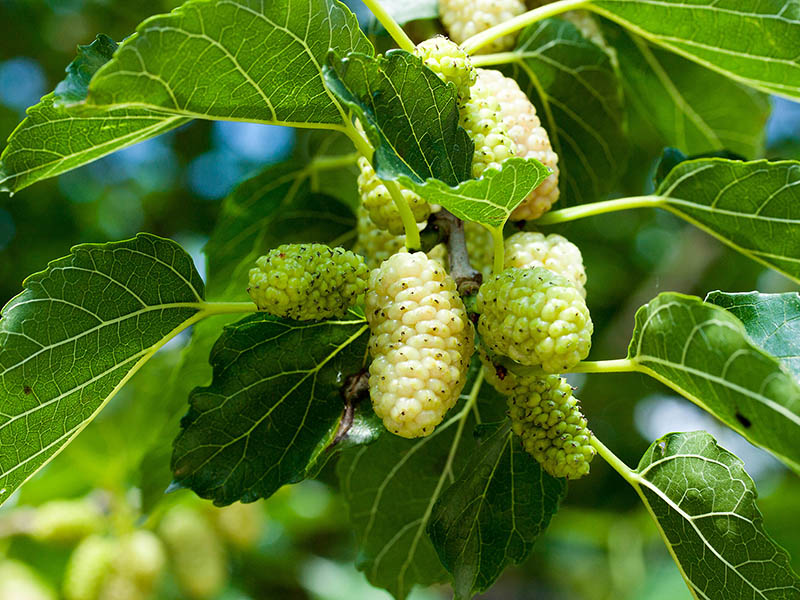
Sang Shen Zi is a type of Mulberry that you can see in China. The plant is closely connected with the cultivation of silkworms, so many people call this version Silkworm Mulberries. The planting of Sang Shen Zi has been ongoing in China for centuries.
There are various versions of the fruit, from red mulberries to white ones (the latter is a common ingredient in some of the best Chinese desserts). An average mulberry tree can grow quite tall, up to around 80 feet (24 meters).
Mulberries are often a type of feed for silkworms. Of course, they’re safe for human consumption as well, with the texture being quite juicy and plump. Both the white and red mulberries are very sweet.
Since mulberries pack a lot of good nutrients, they’re popular for medicinal drinks. You can even use the leaves for an herbal tea type from China. The extract from Mulberries can prevent obesity and stress.
Nutrients: Mulberries are rich in vitamin C and iron and good for your body’s circulation.
Season: Mulberries are likely to be available in the fall.
How to eat: You can also extract Mulberry juice to make drinks, but you have to make sure that the fruits are not green. That’s because green mulberries are unripe and they have a laxative effect, which will cause you to regularly visit the bathroom.
25. Fig (Wu Hua Guo)
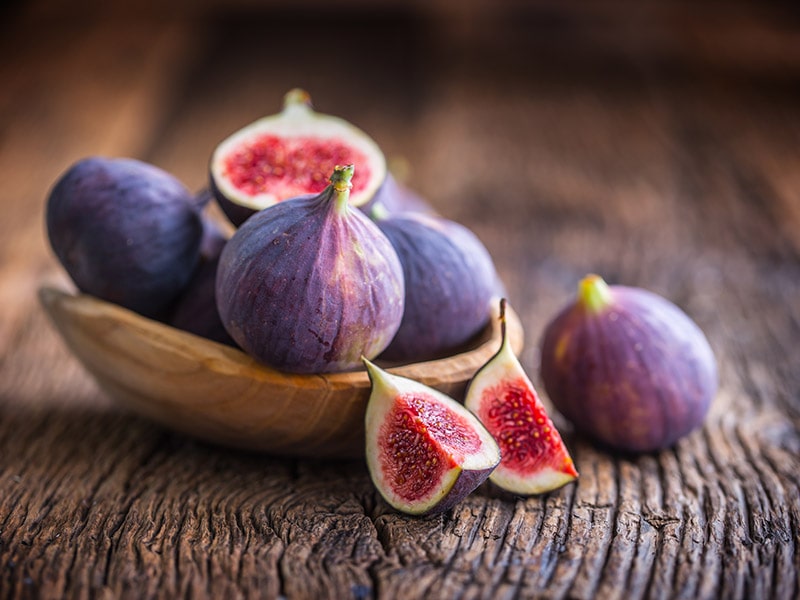
While Fig originated in western Asia and the Mediterranean, the fruit also made its way to the Chinese market a long time ago through trades. The cultivation of the fruit takes place in tropical regions, where the climate remains fairly hot. Even drought cannot stop the growth of the plant.
The appearance of a typical Fig might surprise some people. The exterior seems normal, but the core has a distinct look, with seedy flesh. The taste of this fruit is quite sweet with notes of berry, and the texture is quite soft.
Although the fruit is not native to Chinese lands, Fig is quite popular in China. The region that grows the most Figs in the country is Shandong, specifically the Jiaodong peninsula.
Figs can be used as a cooling agent, to help regulate your body heat according to Chinese knowledge. The Chinese people also utilize Figs as a treatment for chronic dry cough and several colon problems.
Nutrients: Fig has vitamins B6, K, and minerals like potassium and magnesium.
Season: Due to the various regions producing the fruit, you can find figs throughout the year. But if you want to eat the fruit in its best season, try the middle of July to the end of November.
How to eat: You just cut the fruit in the middle to enjoy the fleshy part of a Fig alongside the seeds and skin. Of course, you can also enjoy Fig without the peel and seeds. Other than that, the fruit is good as an ingredient in desserts since you can boil, bake, and even grill the fruit.
26. Chinese Pear (Zhongguo Li)
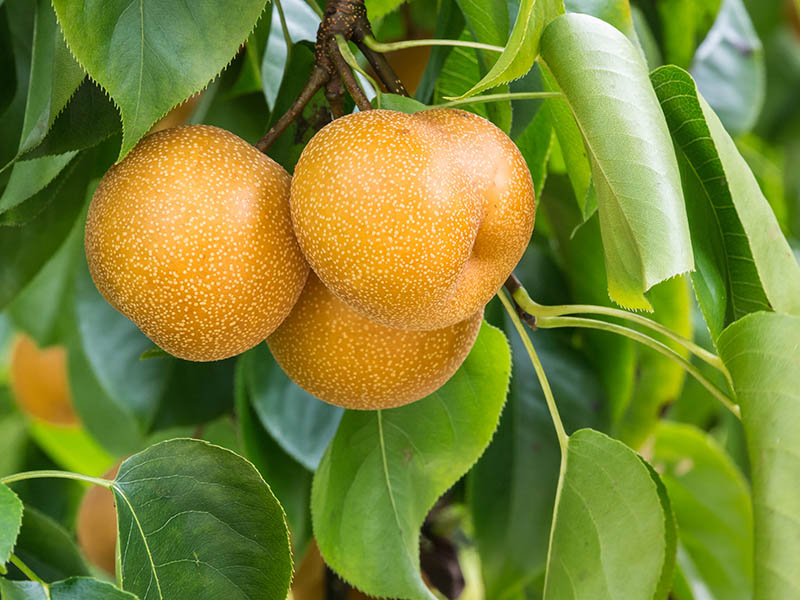
Chinese Pear, or Zhongguo Li, is a species of Pear native to most East Asian countries, including China. Unlike the western version of Pears, the shape of a Chinese Pear is more oval and slightly more prominent.
The outer appearance of a standard Chinese pear is quite lovely. The shape feels round, and the yellow hue keeps luring you into getting a bite. And the taste is even more heavenly when the grainy sweetness overwhelms your taste buds.
This species of pears are quite luxurious and expensive, that’s why many people choose to buy Chinese Pears to give them instead. And when you see the white pear flowers blooming on the street, you know spring is about to arrive
Nutrients: The antioxidants in Chinese Pears prevent the risk of heart disease and control your blood sugar level.
Season: The pear is in season from July until winter.
How to eat: Use a knife to peel the skin and eat the flesh. However, if you don’t have time, you can bite through the skin.
27. Durian (Liu Lian)

Durian, or Liu Lian, is a fruit that you can find in Indonesia, Thailand, Malaysia, and other Southeast Asian countries. The popularity of the fruit comes to a point where many people name it the “King of Fruits” in the region.
The fruits grow on top of a large tree, at a height of 80-165 feet (25-50 meters), and the size of the fruit can come to 12 inches (30 centimeters) in length and 6 inches (15 centimeters) in diameter. The outer skin has a lot of sharp spikes, which means the harvesting process can be dangerous.
Despite the love of Durian all across Southeast Asia and China, this type of fruit is quite infamous due to its pungent and strong smell. However, if you get past the smell to get to the flesh, the creamy texture is just to die for.
The Durian plantation in China is located in the island province of Hainan. The place is where the weather is similar to that of Southeast Asia.
Nutrients: Durian is proven to be nutritious with minerals like folate, copper, and niacin, helping to reduce cancer risks.
Season: The excellent season is from March to July in China for the cultivation of Durians.
How to eat: When you handle a Durian, be extra careful since the spikes are pretty sharp. You have to use a knife to cut open the skin to get to the good part.
The love Chinese people have for Durian is only growing.
Desserts Will Be Better With Fruit Options From China
The best thing about having fruits for dessert is that you don’t have to worry about getting fat. Most of the fruits that I have shown you contain so many nutrients that can improve your health in the long run.
Aside from giving you ideas for your next meal, I want to use this opportunity to introduce you to some of the most popular national and regional fruits of China. I hope the next time you visit the country, you will know what delicacies to get.
Before ending this article, I want to thank you for reading through this. If you have any questions, please ask in the comment section below. If not, just press the like button and share this post on your social media. Have a nice meal!



Truc Tran (Kris)
Expertise
Home Cooking, Meal Planning, Recipe Development, Baking and Pastry, Food Editor, Cooking-video Maker, Asian Food Content Creator, Vietnamese Food Evaluation Expert
Education
Program: Diploma of Hospitality (Commercial Cookery)
Focus: The culinary program included a Certificate III in Commercial Cookery, a Certificate IV in Kitchen Management, and a Diploma of Hospitality Management. This education provided a comprehensive blend of theoretical and practical training in finance, sustainability, diversity, and human resources management.
Program: Culinary Arts at Kendall College (Australia Branch in Sydney)
Focus: Explored global cuisines, and developed entrepreneurial abilities to manage a successful food business, along with acquiring essential language, math, computer, and communication skills for success.
Program: Certificate of Vietnamese Cuisine Head Chef
Focus: Master traditional and modern Vietnamese cooking techniques.
Truc Tran, or Kris, is an accomplished food editor with extensive training in hospitality and culinary arts, including a deep focus on Vietnamese cuisine from various prestigious institutions. She possesses over nine years of experience, developing her expertise in global cuisines and blending traditional Vietnamese cooking with contemporary trends to create engaging and educational content.
She also has a rich educational background, including a Diploma of Hospitality from TasTAFE and a Bachelor of Arts in Culinary Arts from Kendall College’s Sydney branch. It enables her to offer unique insights into meal planning, recipe development, and food culture, making her articles and cooking videos both informative and appealing.